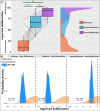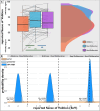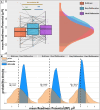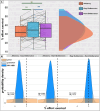A multi-measurement study of the relation between deliberation and volition
- PMID: 40799214
- PMCID: PMC12342383
- DOI: 10.1093/nc/niaf023
A multi-measurement study of the relation between deliberation and volition
Abstract
Historically, voluntary action and volition more generally have been investigated through the lens of meaningless decisions. Importantly, these findings have been used in the debate about key notions like free will and moral responsibility. However, more recent claims have challenged the possibility of generalizing findings from a meaningless context to a more meaningful one. The current study investigates the markers of volition, specifically comparing meaningful and meaningless decisions. In an effort to maximize their monetary gain, 50 participants repeatedly deliberated between two options, making either rewarded choices-hard-deliberation decisions (where the options differed along two dimensions) or easy-deliberation decisions (where the options differed along a single dimension)-or unrewarded choices, a.k.a. arbitrary decision. This enabled us to contrast rewarded and unrewarded decisions as well as the degree of deliberation between easy- and hard-deliberation choices. We found evidence that rewarded and unrewarded decisions differed along several measures related to volition: participants reported a higher sense of volition, exhibited a stronger Readiness Potential, had increased temporal binding (mostly inconclusive), and demonstrated increased Effort Exerted in the rewarded condition. In contrast, we found evidence for similarity across these measures between easy-deliberation and hard-deliberation conditions. Our results suggest that it is not the complexity of the deliberation process prior to the action that makes it more volitional, but rather that the decision serves a meaningful goal. Our study also introduced a new implicit measure of volition- effort exerted-that well aligned with other measures of volition and should therefore prove useful in future studies.
Keywords: agency; intention; volition.
© The Author(s) 2025. Published by Oxford University Press.
Conflict of interest statement
None declared.
Figures









References
-
- Achtziger A, Gollwitzer PM. Motivation and volition in the course of action. In: Heckhausen J, Heckhausen H (eds), Motivation and Action. Cham: Springer International Publishing, 2018, pp. 485–527. 10.1007/978-3-319-65094-4_12 - DOI
LinkOut - more resources
Full Text Sources
